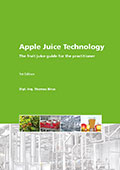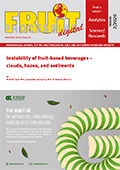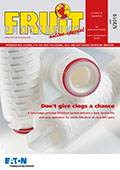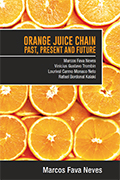The 2024-2025 orange crop forecast for the São Paulo and West-Southwest Minas Gerais citrus belt by Fundecitrus in cooperation with Markestrat and full professors at FEA-RP/USP1 and FCAV/Unesp2, is 232.38 million boxes of 40.8 kg (90 lbs) each. This production is divided as follows (figures in parentheses indicate the drop in production as compared to the previous crop):
- 37.12 million boxes of the Hamlin, Westin, and Rubi varieties (- 36.10 %);
- 15.72 million boxes of the Valencia Americana, Seleta, Pineapple and Alvorada varieties (- 15.07 %);
- 70.97 million boxes of the Pera Rio variety (- 27.30 %);
- 81.58 million boxes of the Valencia and Valencia Folha Murcha varieties (- 22.45 %);
- 26.99 million boxes of the Natal variety (- 2.91 %).
Approximately 14.61 million boxes are expected to be produced in the Triângulo Mineiro (- 47.48 %).
Overall, the projected volume represents a significant drop of 24.36 % as compared to the previous crop that totaled 307.22 million boxes, a value close to the average for the last decade …
Please download the complete forecast under: www.fundecitrus.com.br/pdf
1Marcos Fava Neves, Part-time Full Professor at FEA-RP/USP.
2José Carlos Barbosa, (voluntary) Full Professor at FCAV/Unesp.
Total orange production for the 2023-2024 crop season ended at 307.22 million boxes1
The 2023-2024 orange crop for the São Paulo and West-Southwest Minas Gerais citrus belt, published by Fundecitrus – performed in cooperation with Markestrat and full professors from FEA- RP/USP and FCAV/Unesp2 – concluded with 307.22 million boxes of 40.8 kg each (90 lbs), divided as follows:
- 58.09 million boxes of the Hamlin, Westin and Rubi early-season varieties;
- 18.51 million boxes of the Valencia Americana, Seleta, Pineapple and Alvorada early-season varieties;
- 97.62 million boxes of the Pera Rio mid-season variety;
- 105.20 million boxes of the Valencia and Valencia Folha Murcha late-season varieties;
- 27.80 million boxes of the Natal late-season variety.
Of the total, about 27.82 million boxes were produced in the Triângulo Mineiro region.
The season´s production was 2.22% lower in comparison to the previous crop, which reached 314.21 million boxes and was 0.69% below the initial forecast made in May 2023 …
Please download the complete forecast under: www.fundecitrus.com.br/pdf
1Hamlin, Westin, Rubi, Valencia Americana, Seleta, Pineapple, Alvorada, Pera Rio, Valencia, Valencia Folha Murcha, and, Natal.
2Department of math and science, FCAV/Unesp Jaboticabal Campus.
All oranges 18.8 million boxes
The 2023-2024 Florida all orange forecast released by the USDA Agricultural Statistics Board is lowered 1.00 million boxes to 18.8 million boxes. If realised, this will be 19 percent more than last season’s revised production. The forecast consists of 6.80 million boxes of non-Valencia oranges (early, mid-season, and Navel varieties) and 12.0 million boxes of Valencia oranges. An 8-year regression was used for comparison purposes. All references to “average”, “minimum”, and “maximum” refer to the previous 10 seasons, excluding the 2017-2018 season, which was affected by Hurricane Irma, and the 2022-2023 season, which was affected by Hurricanes Ian and Nicole. Average fruit per tree includes both regular bloom and the first late bloom …
Please download the full citrus crop production forecast: www.nass.usda.gov
Total forecast production of oranges1 remains at 307.22 million boxes
The third forecast for the 2023/24 orange crop in the São Paulo and West-Southwest of Minas Gerais citrus belt, published on February 09, 2024 by Fundecitrus, in cooperation with Markestrat, FEA-RP/USP and FCAV/Unesp2, maintains the projection of 307.22 million boxes of 40.8 kg each, unchanged in total volume from the previous forecast. This represents a reduction of 0.7 % when compared to the initial forecast for the season. Of the total estimated production, approximately 27.76 million boxes are expected to come from the Triângulo Mineiro region …
Please download the complete forecast under: www.fundecitrus.com.br/pdf
1Hamlin, Westin, Rubi, Valencia Americana, Seleta, Pineapple, Alvorada, Pera Rio, Valencia, Valencia Folha Murcha, and, Natal.
2Department of math and science, FCAV/Unesp Jaboticabal Campus.
Prinova has identified growing demand for ingredients for the mind as one of nine emerging food, beverage and nutrition “mega-trends”. In a new report on functional health trends, it also spotlights the increasing prominence of branded ingredients, and growing demand for “real foods”.
The leading provider of ingredients and premixes commissioned expert researchers to analyse patterns in retail and food service and to conduct social media listening. This allowed it to build a framework of nine macro-trends that will shape the industry in 2024 and beyond.
The report highlights the growing number of products containing adaptogens and nootropics, which it attributes to factors such as enduring concerns around performance, focus and “brain fog” in the wake of the pandemic. It also notes growing demand for natural sources of caffeine, such as yerba and matcha, as consumers seek “an antidote to boom and bust caffeination”. Meanwhile, ongoing talk about the stress of modern life, coupled with research on the importance of sleep and rest, has led to “an array of adaptogenic ingredients” being included in everyday food and beverage products.
The Prinova report also notes that “branded ingredients are emerging from the depths of the ingredient list, with logos making their way to the front of product packaging, “particularly in categories like plant-based and performance nutrition. Prinova’s range of branded ingredients includes enduracarb® , a science-backed, slow-release ‘double sugar’ for endurance, and Bacopin®, a bacopa monniera ingredient which, studies show, may help improve memory and attention.
Other mega-trends identified in the report include:
- ‘Real Food Rules’: A shift away from complicated ingredient lists as consumers embrace ingredients in their most natural, unprocessed form. This includes recognising the benefit of animal-based products again, including previously maligned elements such as full fat.
- ‘Hack my Health’: With growing interest in the way products interact with our genotypes, phenotypes and lifestyles, companies are increasingly offering personalised services to cater for unique needs.
- ‘Targeted Nutrition’: Consumers are increasingly aware of the nutritional interventions they can make to improve their wellbeing at different life stages. More knowledgeable than ever, they are looking for products with detailed claims.
James Street, Marketing Director, EMEA & APAC at Prinova, said: “Consumers are looking to food, beverage and nutrition products to meet a growing number of needs. To identify where the opportunities are, and to help our customers create innovative, new products, we’ve created a future-facing framework that identifies the most important emerging trends. We’ve seen how consumers are looking for nutritional ‘hacks’ in areas like cognitive performance and emotional wellbeing, while also yearning for a return to products with ‘real food’ or ‘natural’ credentials. And our research also shows that manufacturers are recognising branded ingredients as one of the best ways to communicate science-backed benefits and bolster credibility.”
Discover the emerging trends in the full report: https://www.prinovaglobal.com/eu/en/resources/news/2024-and-2025-trends
dsm-firmenich, a leading innovator in health, nutrition, and beauty, announces Peach+ as the 12th annual “Flavour of the Year” for 2024. Peach+ was inspired by PANTONE® 13-1023 Peach Fuzz, the 2024 Colour of the Year from PANTONE®, a global colour authority and provider of professional colour language standards and digital solutions for the design community. The selections were based on emerging signals in the cultural and consumer landscape where trends in kindness, community, goodness, and comfort have all been identified as having increasing relevancy. For more than 20 years, both companies have observed many of the same trend sources, drawing inspiration from a wide variety of influences, including culinary, fashion, hair and beauty, packaging and multimedia design, home decor and interior design, architecture, art, and the cultural zeitgeist.
Peach+ is an invitation to dsm-firmenich customers to innovate with this beloved flavour, to go beyond the traditional juicy sweet aspects to also consider softer, smoother, lighter, more refreshing, textural elements.
“Now in its 12th year, the announcement of the Flavour of the Year is an eagerly anticipated event,” said Maurizio Clementi, EVP Taste for Taste, Texture & Health at dsm-firmenich. “The delicate and natural qualities of Peach+ call for diverse applications across multiple food and beverage industries, and we are excited to see the innovations of our clients upon receiving this news.”
Empowering customers with insights into trends
The peach is one of the oldest cultivated fruits in the world, with a 4,000-year-old history that began in China and continues to this day. China is the world leader in peach production and exportation, with over 400 varietals under cultivation.
“Our research reveals that peach has many multifaceted meanings,” said Jeffrey Richard Schmoyer, VP of Human Insights for Taste, Texture & Health at dsm-firmenich. “And peach is incredibly emotional. While the peach has a long history, it also has an innovative future.” According to Emotions 360™, a proprietary dsm-firmenich consumer study that measures consumer emotions associated with ingredients, the peach is somewhat unique in that it has many innate qualities that contrast, such as being both indulgent and pampering, but also refreshing and revitalising, and youthful, but nostalgic.
Peach has been an evergreen fruit flavour in many categories for decades with a steady share of presence in innovations in most regions. Today, peach is growing in popularity in some regions and categories both as the primary tonality and in combination with others. The most prevalent areas of growth for peach new product development are carbonated soft drinks, nectars, candies, ready-to-drink teas, teas, flavoured alcoholic drinks, yogurt and fruit preparations, dairy drinks, juices containing peach, and fruit preserves. Other areas showing promise for growth are functional drinks and powdered soft drinks, as well as more savory opportunities for peach including side dishes, noodles, processed cheeses, and protein analogs. Peach in combination also spiked in favour of passion fruit plus peach, mango plus peach, peach plus tea, and apricot plus peach.
’’Flavour of the Year showcases emerging trends in flavour through proactive sensory experiences and creations, and completes its mission year after year, which is to empower our customers to be leaders in global trends,” says Mikel Cirkus, Global Creative Director for Taste, Texture & Health at dsm-firmenich. The company identifies countless possibilities to put the Plus in Peach for 2024, and confidently envisions how customers can lead with these emerging trends to ultimately create products with high impact and superior business relevancy.
The World Citrus Organisation (WCO) has released its annual Northern Hemisphere Citrus Forecast for the upcoming citrus season (2023-24). The Forecast was released on the occasion of the Global Citrus Outlook conference organized by WCO. The forecast is based on data from Egypt, Greece, Israel, Italy, Morocco, Spain, Tunisia, Turkey, and the United States. This year, the Forecast shows that citrus production is projected to reach 28,976,001 T, which represents a 12.2 % increase compared to the previous peak low season. The 2023/2024 forecast is 1.48 % higher than the average of the last 4 seasons.
WCO, the World Citrus Organisation, released its annual Northern Hemisphere citrus forecast for the upcoming season (2023-24). The preliminary Forecast is based on data from industry associations from the Mediterranean region and the United States. Total citrus exports are expected to follow a similar trend at 9,483,770 T, up by 11.4 % from last season and 4.5 % from the last four seasons’ average.
Philippe Binard, WCO Secretary General, summarised the outcome of the Forecast. “The market insights we received indicate a recovery from the low point of last season. The growth is mainly influenced by growth in Turkey and Egypt while other countries are stable or only recorded marginal gains”. Eric Imbert from CIRAD added, “While this year’s forecast shows a recovery with variable conditions across the producing countries and citrus categories, many parameters have to be taken into account for the market analysis”. He added: “Climatic issues, such as late frost, drought, heat waves, or new pests and diseases influenced the quality, colouring, or harvest date for the production. The market will still be impacted by geopolitical instability while consumer demand is under pressure due to limitation of purchasing power and inflation”.
Looking at the country-specific figures for the largest producers in the EU, Spain’s citrus production at 5.9 MT is up by 2 % to previous seasons, with stable soft citrus compared to last year, fewer oranges (- 6 %) and more lemons. Italy is up by 6 % at 2.6 MT, with more oranges (+ 20 %) and less soft citrus and lemons (- 10 % each), while Greece is down by 7 % to 1.1 MT. In the other Mediterranean countries, Turkey is now the market leader with a first production estimate of 6.5 MT (+ 45 %), with strong growth across all categories. The Turkish production forecast could even exceed 7 MT. This results from the increased acreage and productivity, alternance, and favourable climatic conditions. Egypt at 5.4 MT is up by 10 % from the previous season and 15 % from the average of the last 4 years. The main category is oranges with 3,7 MT (+ 5 %) while soft citrus’s double-digit growth should almost reach 1.3 MT. Morocco’s production is expected to partially recover, bouncing back to just over 2 MT, with 1 MT of soft citrus (+ 11 %) and 930,000 T of oranges. Israel’s production is estimated at 365,000 T, but the recent conflict and attack on the country is a source of multiple challenges regarding supply, logistics, and human resources for harvesting and packing. The production in the United States will be up by 1 % at 4.5 MT with more oranges ( + 10 % at 2.4 MT) but less soft citrus (- 2 % at 856,000 T) and even less so for lemon ( – 12 % at 889,000 T).
Philippe Binard added: “WCO is also setting some trends for the expected utilization of citrus for the upcoming season. The global citrus exports will be up by 11 % to reach 9,4 MT, while processing will increase by 8 % to reach 4,7 MT, leaving 14.7 MT for domestic sales (+ 14 %.). Next April, the WCO will release the 2024 production and export forecast for the Southern Hemisphere.
The yearly WAPA report was published on the occasion of the Prognosfruit held in Trentino (Italy): Italian production levels are stable, France and Spain grow, while Poland and Germany suffer a slump.
The new challenges in the apple industry will headline the Interpoma 2024, the only trade fair in the entire world specialised in apples. The trade fair will run between 21 and 23 November 2024 at the Fiera Bolzano.
During the hiatus between the South Tyrolean trade fair, which takes place every two years – the last edition was held in November 2022 – apple enthusiasts can look forward to Prognosfruit 2023, the yearly, itinerant trade fair during which WAPA, the World Apple and Pear Association, publishes a report containing forecasts on the upcoming European apple harvest. Due to WAPA’s choice of location, this year’s Interpoma supported and promoted Prognosfruit as the event’s Technical Sponsor. This meant that every fairgoer received the second edition of Interpoma’s official magazine, the Ipoma Magazine, printed on 100 % apple paper and bursting with news on the industry. Gerhard Dichgans coordinates the magazine, which goes into detail across numerous topics. The second edition focused on topics such as “Rise and Fall of a Superstar: Why the Red Delicious has gone downhill”, “Precision agriculture and AI predictions in orchards”, “Love and Craft: How Japan raised the apple to the status of cultural asset”, “Juicy Dividends in Normandy: How apples not suited for raw consumption are transformed into cider and Calvados”.
The Prognosfruit 2023 was held in Trentino (Italy) and revealed that forecast European production will reach 11,411,000 tons, a 3.3 % drop compared to last year. The country dragging production down is Poland, the largest European apple producer overall, with a – 11.1 % drop YOY. If we turn to Italy, production levels are strong yet stable, helping it maintain its second position in Europe with an estimated 2,104,000 tons. If we dig deeper, South Tyrolean and Trentino production are on the rise, respectively at + 7 % and + 4 %. Moving to upcoming trends, France and Spain have proved to be quite lively markets: Forecasts for France speak of a harvest equaling 1,501,000 tons, + 7.9 % YOY on growth and + 9.5 % compared to the average of the last three years. Spain performs even better with its 536.000 tons, representing an astounding + 30.1 % YOY growth and + 14.8 % compared to the average of the last three years. However, what goes up, must come down: That fate has befallen Germany, as estimates speak of a harvest yielding 952,000 tons, i.e. – 11.2 % YOY and – 7.9 % compared to the last triennium.
These new trends and much, much more will be in the spotlight between 21 and 23 November 2024 in Bolzano during Interpoma and the satellite Interpoma Congress, where international apple experts gather to exchange ideas and updates about the industry.
2023 -2024 orange crop forecast
The 2023 – 2024 orange crop forecast for the São Paulo and West-Southwest Minas Gerais citrus beltby Fundecitrus in cooperation with Markestrat and full professors at FEA-RP/USP and FCAV/Unesp, is 309.34 million boxes (40.8 kg). Total orange production includes:
- 56.11 million boxes of the Hamlin, Westin and Rubi varieties;
- 18.22 million boxes of the Valencia Americana, Seleta, Pineapple and Alvorada;
- 98.95 million boxes of the Pera Rio variety;
- 105.23 million boxes of the Valencia and Valencia Folha Murcha varieties;
- 30.83 million boxes of the Natal variety.
Approximately 27.02 million boxes are expected to be produced in the Triângulo Mineiro region.
The projected volume is lower only by 1.55 percent as compared to the previous crop, which totaled 314.21 million boxes. That minor difference maintains the production at the same level as in the previous crop season and within the average range for the last ten years, as shown in Graph 1. As compared to the average volume produced in the last decade, the current crop shows a slight increase of 1.04 percent …
Please download the complete forecast under: www.fundecitrus.com.br/pdf
The orange output in the citrus belt in southeastern Brazil (São Paulo and the Triângulo Mineiro) in the 2023/24 season is estimated at 309.34 million boxes of 40.8 kg each, according to data from Fundecitrus (Citrus Defense Fund) released on May 10th. This volume is 1.5 % lower than that harvested last season.
According to Fundecitrus, the major reasons for the lower harvest are rains above the historical average (although they have favoured both the vigor of trees and fruits growth, rains raised flower rotten), the negative biennial cycle (except for northern SP, where productivity was lower last season), lower blooming for some late varieties (whose harvesting was delayed and/or production was high in 2022/23) and the higher incidence of greening, which is expected to raise the rate of fruit fall. On the other hand, high moisture may favour fruits weight, which may be the highest since 2017/18.
As for productivity, the average forecast for the citrus belt is at 918 boxes per hectare, a slight 0.6 % up from that in the 2022/23 season.
Although the harvest expected in the citrus belt is within the average of the last 10 years, the needs of juice processors in SP for oranges is very high. Inventories are low, and the number of oranges to be available is not expected to be enough for stocks to recover.
Indeed, according to a report from CitrusBR released this month, the volume of juice stocked by the processors in SP in Dec/22 was 14.5 % lower than that in the same period of 2021. If this percentage continues stable until the end of the 2022/23 season (on June 30, 2023), ending stocks may total 122.3 thousand tons (juice equivalent), very low – maybe even insufficient – to meet the markets’ demand until the new season steps up.









